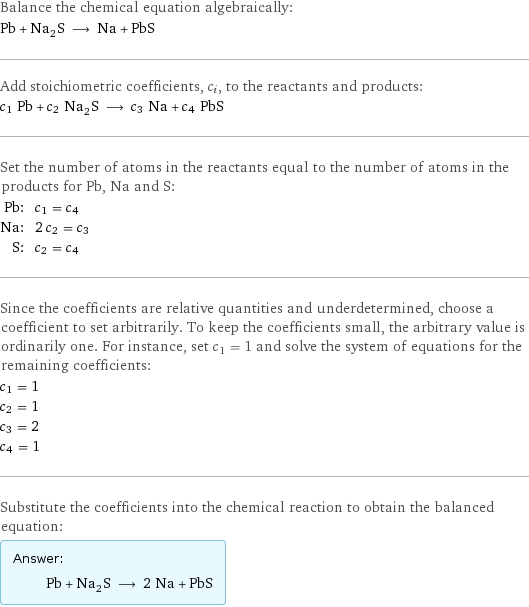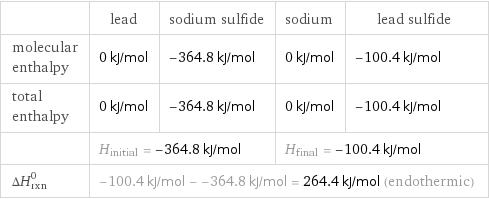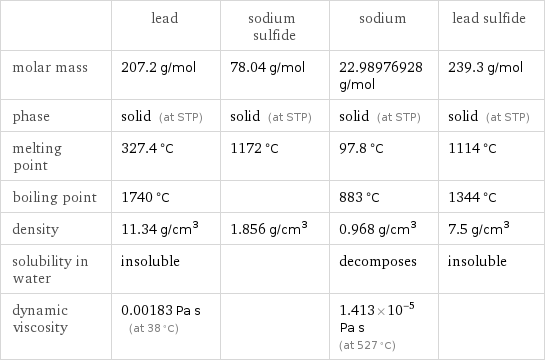Input interpretation

Pb lead + Na_2S sodium sulfide ⟶ Na sodium + PbS lead sulfide
Balanced equation

Balance the chemical equation algebraically: Pb + Na_2S ⟶ Na + PbS Add stoichiometric coefficients, c_i, to the reactants and products: c_1 Pb + c_2 Na_2S ⟶ c_3 Na + c_4 PbS Set the number of atoms in the reactants equal to the number of atoms in the products for Pb, Na and S: Pb: | c_1 = c_4 Na: | 2 c_2 = c_3 S: | c_2 = c_4 Since the coefficients are relative quantities and underdetermined, choose a coefficient to set arbitrarily. To keep the coefficients small, the arbitrary value is ordinarily one. For instance, set c_1 = 1 and solve the system of equations for the remaining coefficients: c_1 = 1 c_2 = 1 c_3 = 2 c_4 = 1 Substitute the coefficients into the chemical reaction to obtain the balanced equation: Answer: | | Pb + Na_2S ⟶ 2 Na + PbS
Structures

+ ⟶ +
Names

lead + sodium sulfide ⟶ sodium + lead sulfide
Reaction thermodynamics
Enthalpy

| lead | sodium sulfide | sodium | lead sulfide molecular enthalpy | 0 kJ/mol | -364.8 kJ/mol | 0 kJ/mol | -100.4 kJ/mol total enthalpy | 0 kJ/mol | -364.8 kJ/mol | 0 kJ/mol | -100.4 kJ/mol | H_initial = -364.8 kJ/mol | | H_final = -100.4 kJ/mol | ΔH_rxn^0 | -100.4 kJ/mol - -364.8 kJ/mol = 264.4 kJ/mol (endothermic) | | |
Equilibrium constant
![Construct the equilibrium constant, K, expression for: Pb + Na_2S ⟶ Na + PbS Plan: • Balance the chemical equation. • Determine the stoichiometric numbers. • Assemble the activity expression for each chemical species. • Use the activity expressions to build the equilibrium constant expression. Write the balanced chemical equation: Pb + Na_2S ⟶ 2 Na + PbS Assign stoichiometric numbers, ν_i, using the stoichiometric coefficients, c_i, from the balanced chemical equation in the following manner: ν_i = -c_i for reactants and ν_i = c_i for products: chemical species | c_i | ν_i Pb | 1 | -1 Na_2S | 1 | -1 Na | 2 | 2 PbS | 1 | 1 Assemble the activity expressions accounting for the state of matter and ν_i: chemical species | c_i | ν_i | activity expression Pb | 1 | -1 | ([Pb])^(-1) Na_2S | 1 | -1 | ([Na2S])^(-1) Na | 2 | 2 | ([Na])^2 PbS | 1 | 1 | [PbS] The equilibrium constant symbol in the concentration basis is: K_c Mulitply the activity expressions to arrive at the K_c expression: Answer: | | K_c = ([Pb])^(-1) ([Na2S])^(-1) ([Na])^2 [PbS] = (([Na])^2 [PbS])/([Pb] [Na2S])](../image_source/a5347b0ef6545f0a4c5d790f663f9323.png)
Construct the equilibrium constant, K, expression for: Pb + Na_2S ⟶ Na + PbS Plan: • Balance the chemical equation. • Determine the stoichiometric numbers. • Assemble the activity expression for each chemical species. • Use the activity expressions to build the equilibrium constant expression. Write the balanced chemical equation: Pb + Na_2S ⟶ 2 Na + PbS Assign stoichiometric numbers, ν_i, using the stoichiometric coefficients, c_i, from the balanced chemical equation in the following manner: ν_i = -c_i for reactants and ν_i = c_i for products: chemical species | c_i | ν_i Pb | 1 | -1 Na_2S | 1 | -1 Na | 2 | 2 PbS | 1 | 1 Assemble the activity expressions accounting for the state of matter and ν_i: chemical species | c_i | ν_i | activity expression Pb | 1 | -1 | ([Pb])^(-1) Na_2S | 1 | -1 | ([Na2S])^(-1) Na | 2 | 2 | ([Na])^2 PbS | 1 | 1 | [PbS] The equilibrium constant symbol in the concentration basis is: K_c Mulitply the activity expressions to arrive at the K_c expression: Answer: | | K_c = ([Pb])^(-1) ([Na2S])^(-1) ([Na])^2 [PbS] = (([Na])^2 [PbS])/([Pb] [Na2S])
Rate of reaction
![Construct the rate of reaction expression for: Pb + Na_2S ⟶ Na + PbS Plan: • Balance the chemical equation. • Determine the stoichiometric numbers. • Assemble the rate term for each chemical species. • Write the rate of reaction expression. Write the balanced chemical equation: Pb + Na_2S ⟶ 2 Na + PbS Assign stoichiometric numbers, ν_i, using the stoichiometric coefficients, c_i, from the balanced chemical equation in the following manner: ν_i = -c_i for reactants and ν_i = c_i for products: chemical species | c_i | ν_i Pb | 1 | -1 Na_2S | 1 | -1 Na | 2 | 2 PbS | 1 | 1 The rate term for each chemical species, B_i, is 1/ν_i(Δ[B_i])/(Δt) where [B_i] is the amount concentration and t is time: chemical species | c_i | ν_i | rate term Pb | 1 | -1 | -(Δ[Pb])/(Δt) Na_2S | 1 | -1 | -(Δ[Na2S])/(Δt) Na | 2 | 2 | 1/2 (Δ[Na])/(Δt) PbS | 1 | 1 | (Δ[PbS])/(Δt) (for infinitesimal rate of change, replace Δ with d) Set the rate terms equal to each other to arrive at the rate expression: Answer: | | rate = -(Δ[Pb])/(Δt) = -(Δ[Na2S])/(Δt) = 1/2 (Δ[Na])/(Δt) = (Δ[PbS])/(Δt) (assuming constant volume and no accumulation of intermediates or side products)](../image_source/fdac214ffd408e68edc7eaae4457655e.png)
Construct the rate of reaction expression for: Pb + Na_2S ⟶ Na + PbS Plan: • Balance the chemical equation. • Determine the stoichiometric numbers. • Assemble the rate term for each chemical species. • Write the rate of reaction expression. Write the balanced chemical equation: Pb + Na_2S ⟶ 2 Na + PbS Assign stoichiometric numbers, ν_i, using the stoichiometric coefficients, c_i, from the balanced chemical equation in the following manner: ν_i = -c_i for reactants and ν_i = c_i for products: chemical species | c_i | ν_i Pb | 1 | -1 Na_2S | 1 | -1 Na | 2 | 2 PbS | 1 | 1 The rate term for each chemical species, B_i, is 1/ν_i(Δ[B_i])/(Δt) where [B_i] is the amount concentration and t is time: chemical species | c_i | ν_i | rate term Pb | 1 | -1 | -(Δ[Pb])/(Δt) Na_2S | 1 | -1 | -(Δ[Na2S])/(Δt) Na | 2 | 2 | 1/2 (Δ[Na])/(Δt) PbS | 1 | 1 | (Δ[PbS])/(Δt) (for infinitesimal rate of change, replace Δ with d) Set the rate terms equal to each other to arrive at the rate expression: Answer: | | rate = -(Δ[Pb])/(Δt) = -(Δ[Na2S])/(Δt) = 1/2 (Δ[Na])/(Δt) = (Δ[PbS])/(Δt) (assuming constant volume and no accumulation of intermediates or side products)
Chemical names and formulas

| lead | sodium sulfide | sodium | lead sulfide formula | Pb | Na_2S | Na | PbS Hill formula | Pb | Na_2S_1 | Na | PbS name | lead | sodium sulfide | sodium | lead sulfide
Substance properties

| lead | sodium sulfide | sodium | lead sulfide molar mass | 207.2 g/mol | 78.04 g/mol | 22.98976928 g/mol | 239.3 g/mol phase | solid (at STP) | solid (at STP) | solid (at STP) | solid (at STP) melting point | 327.4 °C | 1172 °C | 97.8 °C | 1114 °C boiling point | 1740 °C | | 883 °C | 1344 °C density | 11.34 g/cm^3 | 1.856 g/cm^3 | 0.968 g/cm^3 | 7.5 g/cm^3 solubility in water | insoluble | | decomposes | insoluble dynamic viscosity | 0.00183 Pa s (at 38 °C) | | 1.413×10^-5 Pa s (at 527 °C) |
Units
